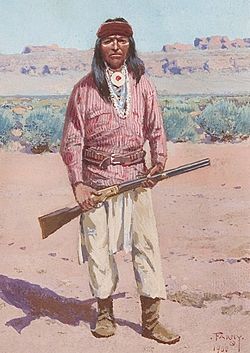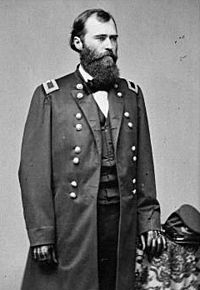Battle of Cibecue Creek facts for kids
Quick facts for kids Battle of Cibecue Creek |
|||||||
|---|---|---|---|---|---|---|---|
| Part of Geronimo's War, Apache Wars | |||||||
 An Apache warrior by William F. Farny |
|||||||
|
|||||||
| Belligerents | |||||||
| Apache | |||||||
| Commanders and leaders | |||||||
| Nock-ay-det-klinne† | |||||||
| Strength | |||||||
| 86 cavalry | ~125 warriors | ||||||
| Casualties and losses | |||||||
| 8 killed 2 wounded |
18 killed | ||||||
The Battle of Cibecue Creek was a fight during the Apache Wars. It happened in August 1881 in Arizona. The battle was between the United States Army and White Mountain Apache people. It took place at Cibecue Creek on the Fort Apache Indian Reservation.
An army group, including Apache scouts, went to arrest Nock-ay-det-klinne. He was a respected Apache medicine man. As the soldiers took him back to the fort, Apache warriors attacked them. During the fight, the soldiers killed Nock-ay-det-klinne. Many of the Apache scouts, who were helping the army, turned against the soldiers. This was the biggest mutiny of its kind in U.S. history. The soldiers then went back to Fort Apache. The next day, the White Mountain Apache attacked the fort. These events caused more trouble. Many White Mountain Apache warriors left the reservation. They joined the famous Apache leader, Geronimo.
Contents
Why the Battle Happened
The Medicine Man and His Dances
Nock-ay-det-klinne was an important medicine man for the Cibecue Apache. He was also a chief of a group called the Cañon Creek band. He often gave advice to famous warriors like Cochise and Geronimo.
Life on the Fort Apache Indian Reservation was hard. There were problems like corruption and unhealthy conditions. Because of this, Nock-ay-det-klinne started holding special ceremonies. These were called ghost dances. This was part of a spiritual movement among Native Americans. They were trying to deal with big changes to their way of life. The dances helped the Apache show their unhappiness with reservation life. They also brought them together.
American settlers in the area became worried. They thought the dances meant the Apache were getting ready for war. So, the Army decided to investigate. They wanted to remove the medicine man from his followers.
Army Scouts and Growing Distrust
Soldiers at Fort Apache included cavalry and infantry. There was also a company of Apache scouts. Captain Edmund Clarence Hentig led one cavalry company. Lieutenant Thomas Cruse led the Apache scouts. Many of Cruse's scouts were from the Cibecue Apache group. Nock-ay-det-klinne was their own chief and medicine man. The scouts often went to Nock-ay-det-klinne's dances.
Lieutenant Cruse noticed a change in his scouts. They used to share information easily. But after the dances, they became quiet. They would not talk about what was happening among other Apache. Cruse felt he could not trust his scouts. He thought they would join their friends if there was a fight. He even suggested they should be let go from the army.
On August 13, Colonel Eugene Asa Carr asked for permission to fire the scouts. He wanted to hire new, more trustworthy ones. Permission was given, but the telegraph line broke. So, Carr did not get the message for weeks.
Taking Away the Guns
The officers regularly checked the scout company. On August 14, Carr told Cruse to take the scouts' guns. Cruse was to say he would keep them safe from rain. The scouts usually kept their guns in the office. They only got them for certain duties or inspections.
The scouts saw this as a sign of distrust. Cruse tried to make them feel better. He thought they were okay with it. But an Irish soldier named John Byrnes was worried. He knew how much the Apache scouts respected Nock-ay-det-klinne. Byrnes warned Cruse not to arm the scouts. He said they could not be trusted. Cruse told Byrnes he was just following Carr's orders.
The Journey to Cibecue
Leaving Fort Apache
On August 28, Carr decided to go to Cibecue. He told Cruse to let the scouts keep their guns. They would leave the next morning to arrest the medicine man.
Around 10:00 am the next day, Carr left Fort Apache. He had five officers, 79 soldiers, and 23 Apache scouts. Cruse took Byrnes as his guide. Carr also had an interpreter and other helpers. Most of the infantry soldiers stayed at Fort Apache.
Carr sent a message to General Willcox. He said he was going to find Nock-ay-det-klinne. But Willcox did not get the message for three days. Carr kept the trip a secret. The scouts did not know where they were going until they started moving.
After crossing the White River, some Apache people rode up. They spoke to the scouts. Carr gathered everyone. He told them he was going to bring Nock-ay-det-klinne in. He said he would not hurt him. He asked the other Apache not to worry.
The group took the Verde Trail. It was a rough path through mountains. They traveled about 29 miles the first day. They camped for the night in a canyon. That evening, Carr gave each scout 20 rounds of ammunition. He talked to them. He said he was not going to hurt the medicine man. He just wanted to talk about the rumors.
Almost an Ambush
Near Cibecue Creek, the trail split. One path was shorter to Nock-ay-det-klinne's village. The other was longer. Cruse, Byrnes, and the scouts reached the fork first. The Apache scouts wanted Cruse to take the longer path. Byrnes, who was suspicious, warned Cruse.
Carr arrived and realized Cruse had taken the longer way. He sent a message for Cruse to take the shorter path. The scouts seemed upset when they had to change trails. Byrnes thought the scouts were trying to lead the soldiers into an ambush. Other officers later agreed.
As the soldiers changed direction, Apache people started appearing. They came out of the creek bottom in small groups. Most headed toward Nock-ay-det-klinne's village. Sanchez, a chief of another Apache group, came up. He was unarmed. He shook hands with Carr. He rode along the column, which made officers think he was counting the soldiers.
The group stopped on a small hill to rest. They were about a mile from Nock-ay-det-klinne's camp. The scouts asked Carr to camp before crossing the creek. They said the grass was better there. They also did not want the horses to eat the Apache's corn. Carr said he needed to get Nock-ay-det-klinne first. So, they kept going.
Arresting Nock-ay-det-klinne
The soldiers crossed the creek and reached Nock-ay-det-klinne's village. It was on a low hill. Cruse, Byrnes, and the scouts arrived first. Nock-ay-det-klinne came out of his wickiup. Cruse told him Carr wanted to see him. Carr arrived around 3:00 pm.
Carr met Nock-ay-det-klinne. He told him why he had come. He said he would treat him as a friend. He would investigate the charges against him. Nock-ay-det-klinne said he was ready to go. Carr told him he would be released in a few days if things were clear.
Carr then ordered a guard for Nock-ay-det-klinne. He warned the medicine man that he would be killed if he tried to escape. He also said he would be killed if anyone tried to rescue him. Nock-ay-det-klinne smiled and said no one would try to rescue him. Carr hoped that having Nock-ay-det-klinne as a hostage would prevent any fighting.
As Carr prepared to leave, Nock-ay-det-klinne delayed the group. He went into his lodge to eat and get his things. This delay lasted about 10 minutes. During this time, Carr and the front part of his group moved ahead. They went through a narrow, brushy part of the trail.
The Battle Begins
Carr and his group moved through the creek bottom. They reached a point where the trail crossed the creek. After crossing, Carr turned onto an old trail. It led to a campsite he had seen earlier. Famous scouts Al Sieber and Tom Horn were with Carr.
While the back half of Carr's group waited for Nock-ay-det-klinne, about 15 armed Apache approached. As the column moved, more armed Apache joined them. They crowded around Nock-ay-det-klinne and his guards. As new groups arrived, there was excited talking. Many of the new Apache wore only a breechclout and cartridge belt. This was a sign they were ready to fight.
Suddenly, the scouts, as suspected, turned against the soldiers. The attacking Apache mostly stayed far away. So, the fight was mainly with rifles. But when the scouts mutinied, there was a brief close-up fight. Captain Hentig was shot and killed first. Private John Sullivan was also killed.
However, scouts under Sieber and Horn managed to get to a small hill. They used their rifles to push back the Apache. They helped the cavalry. Then, they supported a counter-attack that killed many Apache.
As night came, Carr asked his officers what to do. Everyone wanted to leave. Carr decided it was best to get back to Fort Apache quickly. He knew there was "great alarm" at the fort. He also knew that Apache warriors could set up ambushes on the way back.
After dark, the soldiers gathered the bodies of their dead. They could not find Private Miller. Carr ordered a large grave to be dug under his tent. They buried the dead soldiers there.
After the Fight
Leaving the Battle Site
After burying their friends, the soldiers prepared to leave. They did not have enough mules to carry everything. So, they had to leave some supplies behind. They left flour, bacon, and other equipment. They cut open the flour bags and spread the flour on the ground. They destroyed other items they left. They took all usable weapons and ammunition.
The group left the battle site around 11:00 pm. Lieutenant Cruse remembered that everyone was warned to be quiet. They felt that the canyons were full of Apache. The Apache had stolen about half their horses. So, many soldiers had to walk.
Carr put Cruse in charge of the front group. Carr and other officers were next. Then came the pack train with supplies. The wounded men were carried on horses. They were Private Baege, Private Thomas J. F. Foran, and Sergeant John McDonald.
Return to Fort Apache
The group arrived back at Fort Apache around 3:00 pm. Seven soldiers were killed and two were wounded. Many horses and mules were also killed or missing. John Byrnes killed the wounded Nock-ay-det-klinne under Carr's orders. Nock-ay-det-klinne was one of 18 Apache killed in the fight.
Carr believed fewer than 60 Apache, including the scouts, attacked at first. He thought fewer than 200 fought at any time. Most of the damage to his group happened at the very beginning. Before the attack, the officers thought the Apache were peaceful.
Lieutenant Carter later wrote about the battle. He said that General Carr's bravery helped save the group. The soldiers were surprised by the attack. Not only did the medicine man's friends attack, but also their own Apache scouts. This could have destroyed the whole group. But Carr's skill and courage helped them survive.
What Happened Next
The battle ended with a strategic victory for the Apache. Even though they could not save their leader, the soldiers had to retreat. After the battle, the Army buried six soldiers. They also buried Nock-ay-det-klinne, his wife, and young son. The son was killed riding on his father's pony. One soldier was never found. Another died the next day from his wounds. Four soldiers received the Medal of Honor for their bravery.
The Cibecue fight caused a bigger Apache uprising. Important warriors like Naiche, Juh, and Geronimo left the reservation. They went to war. They tried to drive out the European Americans from Arizona, New Mexico, and northern Mexico. The fighting lasted about two years. In the end, the U.S. defeated the Apache.
|


